In the last century most of El Salvador’s rainforest has been cut down, for either charcoal or to make room for agriculture such as coffee plantations. This means that the habitat for animals has been shrinking drastically. The country has various national parks which were made to protect its sensible landscapes with its fauna and flora. El Salvador has many bird species and currently has 593 recorded species. Some iconic birds are the turquoise-browed motmot (the country’s national bird), toucans, quetzals, hummingbirds, vultures and more. Among mammals we can find water opossums, ocelots, pumas, humpback whales, dolphins, spider monkeys, jaguars, margays, tapirs, grisons and more. Among the reptiles we have American crocodiles, vipers, rattlesnakes, caimans, boas, iguanas, leatherback sea turtles and more. The country is also a paradise for butterfly lovers with thousands of butterfly species.
Below we’ll have a look at some of El Salvador’s unique animals.
Turquoise-browed motmot
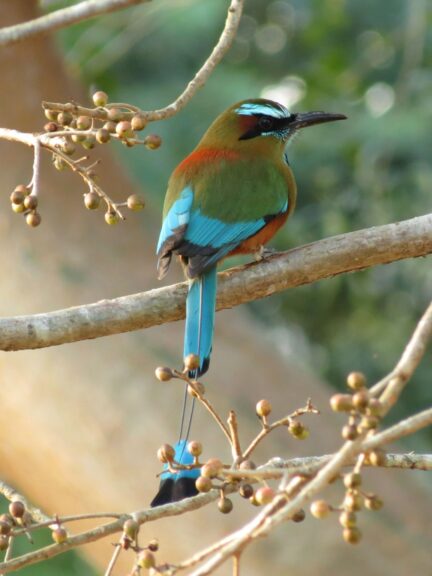
This bird needs a special mention as it’s the national bird of El Salvador. The turquoise-browed motmot (Eumomota superciliosa) lives in Central America and is also observed in South America. This bird of singular beauty is known as torogoz in El Salvador and was declared the national bird in 1999). It is a relatively small bird, on average it is 34 cm long and about 65 grams in weight. The color is mostly green with a reddish back and belly and also we can see several shades of green, blue, white, yellow, orange and black.
It has a blue stripe over the eye, and a black vertical mark on its throat with a blue margin. The flight feathers and the upper surface of the tail are also blue.
Its most characteristic feature is the two long feathers from its tail with a long, wide feather at the end. Sometimes, especially when alarmed, it swings its tail like a pendulum from one side to the other, hence its Yucatecan nickname “clock bird”.
We can find him in fairly open habitats, such as forest edges and scrub. It is more conspicuous than other motmots and frequently perches on wires and fences, crouching on mesh or telephone wires, wagging its tail from one side to the other. There it looks for prey such as insects and small reptiles, also feeding on fruits.
It builds its nest in limestone areas or in the ground, making a hole next to a road, a river or a stream and lays 3 to 5 white eggs in a burrow on a hill or sometimes in a quarry. They reproduce between May and June.
Nine-Banded Armadillo

The nine-banded armadillo (Dasypus novemcinctus) is a mammal species of the armadillos and is one of the best known and most widespread representatives of this group, and it is also the best researched. We can find the nine-banded armadillo in large parts of South America as well as parts of North-America.
The habitat of the nine-banded armadillo is very diverse: mainly forests and partly open landscapes, well moistened. The armadillo is very adaptable, but it cannot deal with long periods of cold weather. They live solitary and dig underground burrows and mate once a year. The mother usually gets four young, who remain with the mother for up to nine months.
The armadillo species is quite adaptable in terms of food and mainly eats insects, and smaller vertebrates. Due to the wide distribution, up to seven subspecies are distinguished. Because the nine-banded armadillo carries pathogens of leprosy and chagas disease he is therefore often used as a laboratory animal and is significant in its relationship to humans. It is also considered a food resource in some countries. The nine-banded armadillo is not listed as endangered.
Water Opossum
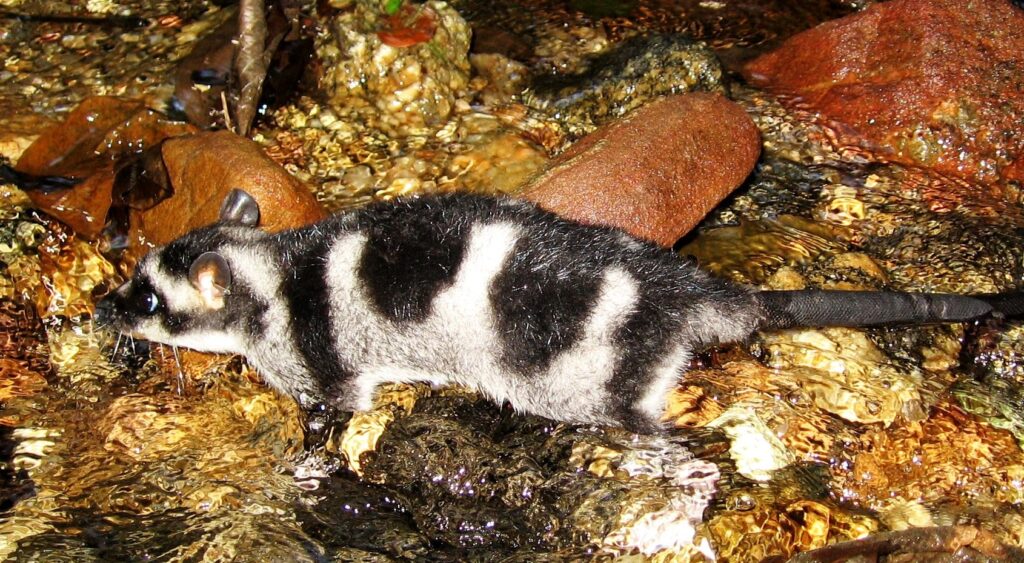
The water opossum (Chironectes minimus) is a Latin American marsupial from the family of possums. It is the only fully aquatic marsupial, and the only living marsupial in which both sexes have a pouch.
The water possum is a medium-sized possum with a gray short, dense coat and a pattern of four black spots and a thin black stripe on its back. His belly is completely white and he has a long rounded tail which is black with a small white tip.
He is adapted to life in water and has a water repellent coat. His hind legs are wide and fully webbed and the front legs are broad with long, slender fingers with cushions for a better grip on slippery fish. The water possum is the only possum in which the male also has a pouch, so he can hide his scrotum when he swims or runs. The water possum is found in Central and Central South America and is seldomly found far from water. He prefers small, fast streams with a rocky or pebble bottom in wooded hilly areas, but can also be found along lakes, ponds and other rivers and, in tropical and subtropical forests.
The water possum is a solitary, semi-aquatic nocturnal animal who sleeps in a permanent underground burrow in the bank, near the water surface with the opening just above the waterline. The nest chamber is made of leaves and grass. He hunts in the night: mostly fish, crabs, insects and sometimes fogs. He keeps his eyes above the water while swimming and drags his prey to the shore to eat it. He dives into the water and hides in the nearest burrow when there is danger.
Ocelot
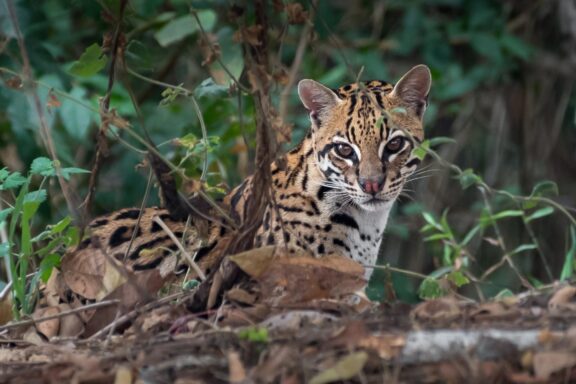
The ocelot (Leopardus pardalis) is a small cat that, together with the marga, tiger cat, Geoffroy’s cat and night cat, belongs to the group of the pardel cats. The ocelot lives from Central America to South America. This cat has remarkably long legs and its body reaches to about 125 centimeters in length with a tail of almost 40 centimeters. The ocelot can weigh up to 16 kilograms and his fur has a leopard pattern or sometimes black fur.
The ocelot lives in different kinds of environments such as scrublands and tropical forest and does well in rock and shrub environments, preferably humid areas. He is a great climber and spends a lot of time in trees. The ocelot is found from South America all the way to Texas. Despite it being hunted for its fur, it is the most common feline in South America. Its survival is threatened by logging.
Ocelots mainly eat rabbits and small rodents such as rats, squirrels and agoutis. They also hunt small deer, birds, lizards, monkeys and even snakes, insects, turtles, frogs, land crabs and fish. He hunts mainly at night and preferably on the ground. As soon as it sees a prey, it presses down to the floor and waits for the right moment to strike. His eyes and ears are excellent for tracking prey at night. With one fast bite in the neck, he quickly kills his prey.
The ocelot lives solitary or sometimes in pairs. Ocelots are territorial and mark trees and shrubs with their urine. During the day they usually rest in a hollow tree or on a tree branch.
The mating season runs all year round and mostly one young (sometimes 2 or 3) is born and hidden between the roots, rocks, a hollow tree, but preferably a thorny thicket.The female raises the young alone.
The word ocelot comes from Nahuatl, the language of the Aztecs. However, they called the animal tlahcoocelotl, the animal they called ocelot is the jaguar.
Leatherback Turtle
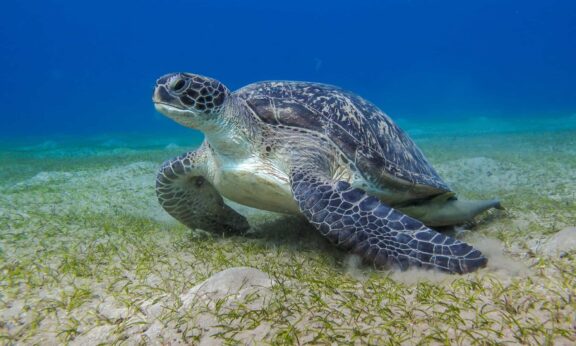
The leatherback turtle (Dermochelys coriacea) is a species of turtle in the Dermochelyidae family and is the largest sea turtle. It does not have keratinized scales on its carapace, but a skin on dermal bones.
The leatherback sea turtle can be found in all the oceans and is seriously threatened by poaching, fishing nets, pollution and by global warming as the temperature of the sand influences the sex of the future turtle. It is therefore listed on the IUCN Red List of endangered species.
The most remarkable feature of the leatherback turtle is its silhouette with its back covered with a skin shell looking like leather in dark blue color with small white dots. The head is very large, with a long neck and the face is dark pink in color. He has strongly flattened limbs to paddle
When hatched, baby turtles measure 7 to 8 cm and weigh only a few dozen grams and full-grown adults weigh around 400 kg and are 1.5 m in length on average depending on the location. The largest leatherback turtle ever found was 915 kg. The leatherback turtle is an excellent diver and can dive up to 1,300 m deep and can stay submerged for up to eighty minutes extracting oxygen from the water using long taste buds in their throats and scavenging dissolved oxygen in some of its tissues.
During the nesting season, between two nestings, leatherback turtles migrate a short distance. The home range is larger than in other species of sea turtles during this inter-laying period, female leatherbacks move further away from the beaches/
Leatherback turtles seem to prefer areas of ocean fronts, where waters with contrasting characteristics meet, for example the area where the icy waters of the Labrador Current meet the warm waters of the Gulf Stream in the North Atlantic or along the Kuroshio Current in the Pacific. These are areas where zooplankton are likely to concentrate en masse. This species thus travels several thousand kilometers during its transoceanic journeys to reach its feeding grounds for jellyfish. They progress by orienting themselves with the help of the earth’s magnetic field.
Jellyfish make up most of the leatherback’s diet, but it can also feed on salps, fish, crustaceans, squid, sea urchins and even certain plants, including algae (mainly eaten by young specimens).
Jaguar
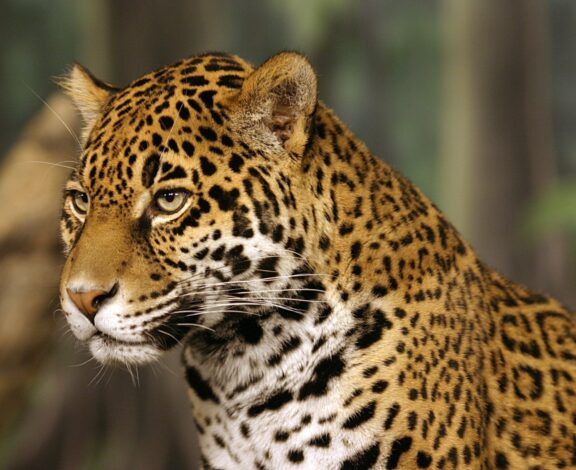
The jaguar (Panthera onca) is a predator of the feline family and can be found in Central America and much of South America. It is superficially very similar to the leopard, but is more heavily built and has a more robust rosette pattern.
Jaguars are 110 to 180 cm long with a tail of 45 to 75 cm and can weigh up to 100 kg. Male jaguars are larger and heavier than females.
The jaguar is the largest and strongest cat in America. It is a sturdily built and powerful animal with a broad head and strong jaws. The legs are relatively short, but very strong. The tail provides balance when jumping. The coat is light yellow to reddish brown with black spots. In the middle of the back, the row of black spots sometimes changes into a continuous line. There is also a melanistic (black) variant, where the spots can be seen in the sun. Because of the round pupils, the jaguar can see well during twilight. The soft foot pads allow the jaguar to sneak well, and the jaguar also has retractable claws and long and sturdy fangs. Jaguars can live 12 to 15 years in the wild, in captivity they can live several years.
Jaguars can be found in dense cloud forests and rainforest to coastal forests. They also occur in dry forests and more open terrain, as long as there is enough cover of grass and rocks to hunt and prefer to live near water and generally hardly go further than 500 meters from it.
Every animal found in the jaguar’s habitat is a potential and they generally feed on the prey items most abundant in a given area. Ground-dwelling mammals such as deer are preferred, as well as monkeys, opossums, armadillos, various rodents, ground-nesting birds, frogs, caimans, turtles, fish , eggs and even giant snakes. The jaguar is the only big cat that regularly kills reptiles.
Jaguars are mainly active in the morning and evening twilight. They are solitary and mark their territory with scratch marks. Different territories regularly overlap. Jaguars are excellent swimmers and mostly hunt on the forest floor, although these cats are also good climbers. They can only sustain high speeds for a limited time and must get as close as possible to its prey in order to be successful in the hunt. The shells of turtles and armadillos do not hinder the jaguar and are opened with his powerful jaws. The jaguar opens caimans down the sides, where the protective horn plates are missing. They are considered to be among the strongest cats and are also good fishermen. As soon as it sees a fish, it is knocked out of the water onto the bank with its paw.
Jaguarundi
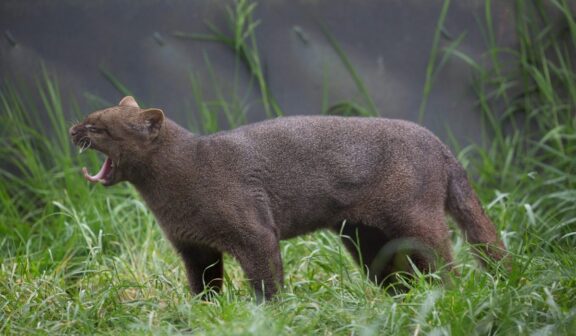
The jaguarundi (Herpailurus yaguaroundi) is a feline belonging to the genus
Acinonychini. This predator is believed to have evolved from the same ancestor as the cougar. It is the only species of the genus Herpailurus.
Its length is 50 to 77 cm with a tail of 33 to 60 cm long and it weighs up to nine kilograms. This cat can live to be about 15 years old.
The jaguarundi looks more like a mustelid than a cat in terms of its build. His body is longer compared to other small cats and he has a rounder head, smaller ears and a shorter, pointed muzzle. His legs are short and sturdy. The coat is not spotted and is either gray-brown or red-brown. It was initially classified as two different species. Later it turned out that it was one species and the two color types also mate. In one litter youngsters can appear with both gray and red fur. Young can also have a spotted coat, although this is only temporary. Populations that live in the forests are usually darker in color than the jaguarundis that inhabit the open grasslands. Males are slightly larger and stockier than females.
Jaguarundis live in a variety of habitats from sea level to 3200 meters in South and Central America, from Argentina to the southern United States. They prefer densely vegetated lowland areas near water, such as riverine forests and swamps. In addition, rainforests, savannas and dry forests are also part of the habitat.
The jaguarundi mainly hunts birds and small mammals such as rodents, lizards, frogs, fish and also consumes fruit. It is one of the few cats that eats sweet food.
They usually hunt during the day, especially late in the morning, mostly on the ground, but he is also an excellent climber and can also swim well. Female jaguarundis’ territory is 13 to 20 km², while that of male jaguarundis is generally larger. They are solitary animals, but sometimes live in pairs or even in small groups. The jaguarundi avoids direct competition with the paradel cats (ocelot, margay, etc.).








